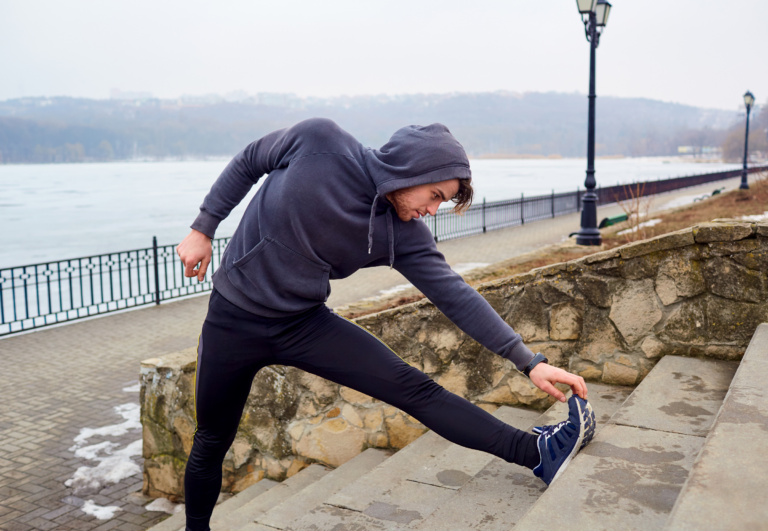How to Warm Up Before a Run: Essential Exercises and Routines for Runners
Warming up before a run is a critical step to awaken your muscles, increase your core temperature, and reduce the risk of injury. It’s a way to signal to your body that it’s time to transition from a resting state to a state of physical activity. As a runner, easing into your routine with a warm-up will help improve your performance and make your running experience more enjoyable.
A good warm-up should last between 5 to 10 minutes and incorporate movements that increase your heart rate and loosen your joints. Instead of static stretching, which might do more harm than good before your muscles are warm, opt for dynamic exercises. These include movements such as leg swings, arm circles, and brisk walking that mimic running motion, promoting blood flow and priming your body for the exercise to come.
Begin your warm-up routine with gentle aerobic exercises like a brisk walk or slow jog. Follow this with dynamic stretches such as walking lunges and leg cradles to ensure your muscles are ready for the demands of running. The key is to start slowly and gradually increase intensity, allowing your muscles to warm up without becoming fatigued before your run even starts.
5-Minute Quick Warm-Up for Runners
Before heading out for a run, it’s essential to prime your body. A short yet effective 5-minute warm-up can do wonders for preparing you for your workout and preventing injuries.
Start with 1 minute of marching on the spot. Keep your posture straight and lift your knees high. This activates your core and leg muscles. Next, move into walking lunges for 1 minute. Step forward with one leg, lowering your hips until both knees are bent at about a 90-degree angle. Ensure your front knee is directly above your ankle, not pushed out too far, and that your other knee doesn’t touch the ground.
For 30 seconds, perform butt kicks, where you jog in place while kicking your heels up towards your glutes. This helps stretch your quadriceps and gets your heart rate up. Then, spend the following 30 seconds doing dynamic warmup routines such as leg swings and arm circles to increase your range of motion.
Finally, transition into a light jog for the remaining 2 minutes, gradually increasing your pace. This jog serves as a bridge from the dynamic exercises to your actual running pace.
| Time | Exercise |
|---|---|
| 0-1 min | Marching |
| 1-2 mins | Walking Lunges |
| 2-2:30 mins | Butt Kicks |
| 2:30-3 mins | Leg Swings and Arm Circles |
| 3-5 mins | Light Jog |
Incorporate this straightforward routine before your runs to enhance performance and mitigate the risk of injury. With consistent practice, these exercises can help maintain your running form and health.
Comprehensive 15-Minute Routine for Runners
A comprehensive 15-minute warm-up routine for runners should include a combination of dynamic stretching to improve range of motion, as well as light aerobic activity to raise the heart rate and increase blood flow to the muscles. Here’s a sample routine that you can follow:
- 1. Walking (3 minutes): Start with a brisk walk to gently increase your heart rate.
- 2. Dynamic Leg Swings (2 minutes): Stand on one leg and swing the other leg forward and back, then side to side, for 30 seconds each leg.
- 3. High Knees (1 minute): Jog in place, bringing your knees up high to engage the core and hip flexors.
- 4. Butt Kicks (1 minute): Jog in place, kicking your heels up towards your buttocks to warm up your hamstrings.
- 5. Arm Circles (1 minute): Perform arm circles both forwards and backwards to loosen up the shoulders.
- 6. Torso Twists (1 minute): With your feet planted and knees slightly bent, twist your torso from side to side to warm up the spine and core.
- 7. Lunge with a Twist (2 minutes): Step forward into a lunge and add a twist towards the leg that is in front, alternating sides.
- 8. Inchworms (2 minutes): From standing, hinge at the hips to touch the ground, walk your hands out to a plank position, then walk your feet back towards your hands.
- 9. Leg Crossovers (1 minute): Lie on your back with arms out to the sides and swing your legs side to side in a scissor-like motion to stretch the lower back and hips.
- 10. Ankle Rolls (1 minute): Lift one foot off the ground and roll the ankle clockwise and then counterclockwise, then switch feet.
This routine incorporates full-body dynamic movements that target the key areas used while running. It’s designed to be done at a comfortable pace, gradually increasing in intensity to prepare your body for the demands of your run. Remember to listen to your body and modify as needed based on how you feel.

Extended 30-Minute Warm-Up for Runners

Before you lace up for your run, a 30-minute warm-up can substantially enhance your performance and reduce the risk of injury. Your extended warm-up should be a combination of light aerobic activity and dynamic exercises to prep your body for the run ahead.
Phase 1: Light Aerobic Activity (5 minutes)
- Purpose: Gradually increase heart rate and blood circulation
- Activity: Begin with a brisk 5-minute walk, transitioning into a gentle jog.
Phase 2: Dynamic Stretching (10 minutes)
- Purpose: Improve range of motion and activate key muscle groups
- Exercises:
- Leg Swings (1 minute each leg)
- Walking Lunges (2 minutes)
- Butt Kicks (2 minutes)
- Hip Circles (1 minute each direction)
- Arm Circles (2 minutes, increase size gradually)
- Toe Touches (2 minutes, alternate left and right)
Be sure to maintain proper form and keep the movements controlled.

Phase 3: Specific Movement Patterns (10 minutes)
- Purpose: Enact running-related motions, enhancing muscle memory
- Activity:
- High knees (1 minute)
- Frankenstein walk (1 minute)
- Side shuffles (2 minutes, switch direction after 1 minute)
- Skipping for height (2 minutes)
- Skipping for distance (2 minutes)
- Backward jogging (2 minutes)
Phase 4: Pre-Run Activation (5 minutes)
- Purpose: Finalize the warm-up by elevating body temperature to running levels
- Activity: Perform a series of 30-second running intervals at a moderate pace, interspersed with 30 seconds of rest or walking.
Remember to hydrate throughout your warm-up and listen to your body. If any particular area feels tight or needs extra attention, don’t hesitate to focus on it. This comprehensive routine will ensure you’re optimally ready to hit the pavement or trail.
The Importance of Warming Up

Before you set out for your run, it’s crucial to engage in a warm-up to prepare your body. This routine increases muscle temperature and heart rate, which enhances your oxygen intake and blood flow, setting the stage for a more effective performance.
Benefits of Proper Warm-Up
Properly warming up activates your cardiovascular system, elevating your heart rate and increasing blood flow to your muscles. This process helps:
- Boost muscle efficiency: Warmed muscles can better use the oxygen delivered during exercise.
- Enhance range of motion: Joints become more lubricated, which may increase your range of motion.
| Benefit | Description |
|---|---|
| Oxygen Efficiency | Oxygen is more readily used by warmed muscles. |
| Range of Motion Improvement | Lubricated joints allow for greater flexibility. |
Impact on Performance
When you warm up, your body’s physiological processes adjust to the impending exercise demand:
- Steady heart rate increase: This gradual change helps prevent sudden stress on your heart.
- Muscle temperature rise: Warm muscles exhibit greater flexibility and power.
| Performance Factor | Effect |
|---|---|
| Heart Rate | Gradually increases to match exercise demand. |
| Muscle Readiness | Warmer muscles perform with more power. |
Injury Prevention Strategies
Starting your run with cold muscles and joints can lead to injuries due to the lack of proper blood flow and preparation. To prevent this:
- Begin with dynamic stretches: Engage in light movements that mimic your running motion to gently prepare your muscles.
- Use a stepwise approach: Start with low-intensity activity and then gradually build up to your running pace.
| Strategy | How It Helps |
|---|---|
| Dynamic Stretching | Prepares muscles with movement-specific exercises. |
| Gradual Intensity Buildup | Lowers the chance of muscle soreness and injury. |
Remember that a warm-up is not just a precaution but a fundamental part of your running routine to enhance overall performance and reduce the risk of injury.
Basic Warm-Up Principles
Warming up before a run is essential; it prepares your muscles for the workout to come and should include dynamic stretching to ensure your body is ready to perform.
Duration and Intensity
Duration: Start with a warming up period of at least 5 to 10 minutes. The focus here is on increasing muscle temperature and blood flow, not on wearing yourself out.
Intensity: The activities should begin at a low intensity and gradually build up to just below your running intensity. Remember, the goal is to prime your body, not pre-exhaust it.
Dynamic vs Static Stretching
Dynamic Stretching: This involves movement-oriented stretches—think leg swings or arm circles—that improve range of motion and mimic the activity you’re about to do. Here’s how to include dynamic stretches in your warm-up:
- Leg Swings (Forward and Sideways): 10 swings per leg
- Arm Circles: 10-12 circles in each direction
- Walking Lunges: A set of 8-12 reps
Static Stretching: Save static stretching, which involves holding a position for 30 seconds or more, for the post-run cooldown to help with flexibility. Static stretches before running can actually decrease performance and increase risk of injury.
Anatomical Focus Areas for Runners
To optimize your running performance and minimize injury risk, prioritize warming up these key anatomical areas: lower body, upper body, and core.
Lower Body
Your lower body is the driving force behind your running performance. It’s crucial to prepare your hips, glutes, quads, hamstrings, and ankles to handle the repetitive impact of running.
- Hips and Glutes:
- Exercises: Hip circles, walking lunges
- Purpose: Increases mobility and activates muscles
- Quads and Hamstrings:
- Exercises: Leg swings, squats
- Purpose: Loosens muscles and prepares them for the run
- Knees and Ankles:
- Exercises: Knee to chest, ankle rotations
- Purpose: Improves joint flexibility and stability
Upper Body
Your upper body contributes to a balanced and efficient running form. Focus on the chest and shoulder movements to promote better posture and upper body rhythm.
- Chest:
- Exercises: Arm crosses, push-ups
- Purpose: Enhances upper body motion and coordination
Core Stability
A strong core maintains your running posture and balance, essential for a steady gait. Include exercises that target your lower back and hip flexors to support your spine and pelvis alignment.
- Core and Lower Back:
- Exercises: Planks, bird-dogs
- Purpose: Strengthens midsection and supports lower back
Implementing a warm-up routine that includes these areas can greatly improve your running efficiency and can help prevent injuries.
Specific Warm-Up Exercises
Before you start your run, it’s crucial to prepare your body with specific exercises that enhance mobility and activate your muscles. This reduces the risk of injury and improves your performance.
Dynamic Lower Body Exercises
Lunges: Lunges are great for activating your leg muscles. Start with forward lunges, then progress to side lunges to target different muscle groups.
Leg Swings: Begin with forward and backward leg swings, gradually increasing the range of motion. Follow with side-to-side swings to open up your hips.
Exercise Table:
| Exercise | Sets | Repetitions |
|---|---|---|
| Forward Lunge | 2 | 8 per leg |
| Side Lunge | 2 | 8 per leg |
| Leg Swings | 2 | 10 per leg |
Upper Body and Core Activation
Planks: Hold a plank for 30 seconds to fire up your core.
Arm Circles: Perform arm circles, both small and large, to engage shoulder muscles.
Exercise List:
- Planks: 1 set, hold for 30 seconds
- Arm Circles: 1 set, 10 circles each direction
Breathing and Cardiovascular Prep
High Knees: Do high knees for 30 seconds to increase your heart rate and improve your breathing rhythm.
Jogging: Start with light jogging in place or around the area to gradually raise your cardiovascular activity level.
Exercise Overview:
- High Knees: 30 seconds for increased heart rate
- Light Jogging: 5 minutes to prepare your cardiovascular system
By incorporating these specific exercises into your warm-up routine, you’ll be well-equipped for a successful and injury-free run.
Advanced Warm-Up Techniques
To optimize your running performance and prevent injury, advanced warm-up techniques that incorporate mobility drills, plyometric exercises, and sport-specific strategies are essential. These activities prepare your body’s muscles and cardiovascular system for the demands of running, increasing circulation and energy while enhancing mobility and stability.
Mobility Drills
Objective: Increase joint mobility and reduce muscle tension.
- Leg Swings: Stand on one leg, swing the other leg forward and back, then side to side. Perform 10-15 swings in each direction to promote hip flexibility.
- Lunge with a Twist: Step forward into a lunge and rotate your torso towards the front knee. Hold for 2-3 seconds, switch legs, and repeat for 8-10 reps each side for added spine mobility.
Plyometric Exercises
Objective: Boost explosiveness and energy capacity.
- Box Jumps: Find a stable platform and explosively jump onto the box from a standing position, then step back down. Complete 2 sets of 5-8 reps to enhance power in your legs.
- Weighted Lunges: Holding dumbbells or a barbell, step forward into a lunge and lower your hips until both knees are bent at a 90-degree angle. Drive back up and repeat. Aim for 2 sets of 8-12 lunges on each leg to build strength and stability.
Sport-Specific Strategies
Objective: Mimic the movement patterns you’ll use while running to improve performance.
- Sprints: After a light jog, perform 4-6 short, high-intensity sprints to activate your fast-twitch muscle fibers and prepare your body for the fast pace.
- Running Drills: Include high knees, butt kicks, and A-skips in your warm-up for improved running form and leg turnover. Perform each drill for 30 seconds to one minute.
Monitoring Your Warm-Up
Effectively monitoring your warm-up can enhance performance and reduce injury risk. Utilize technology to track progress and listen to your body’s signals to adjust intensity.
Using Technology and Apps
Technology can be a valuable ally in your warm-up routine. Apps can track your heart rate and ensure you’re working within the right intensity for a warm-up. Aim for a heart rate that’s about 50-70% of your maximum heart rate. Apps like Strava or Runkeeper can help you monitor this. Additionally, wearable technology like a heart rate monitor or a smartwatch can give real-time feedback.
For a more scientific approach, consult studies, such as those published in the Journal of Strength and Conditioning Research, which highlight the effectiveness of various warm-up routines. These can be used to tailor your app settings to what’s scientifically shown as most effective for other athletes.
| App Feature | Benefit |
|---|---|
| Real-time heart rate | Ensures safe warm-up intensity |
| Progress tracking | Records improvements over time |
| Scientific-based plans | Aligns your routine with research |
Listening to Your Body
While technology is helpful, the best gauge is your body’s feedback. A Rate of Perceived Exertion (RPE) scale helps assess how hard you feel you’re working based on physical sensations such as breathlessness and muscle fatigue. Stay in the lower range (1-4 on a scale of 10) during your warm-up.
Be aware of any discomfort or pain. If a movement causes pain, modify or skip it. The Journal of Human Kinetics suggests that an effective warm-up should gradually increase in intensity without exceeding your pain threshold. Trust your instinct—if it doesn’t feel right, take it down a notch. Listen to your body to refine your warm-up and establish a routine that’s both energizing and gentle on your muscles and joints.
Keep a simple warm-up journal on a platform like Runkeeper or even physical notebook and note how different routines affect your body. Did you feel well-prepared for your run? Was there any discomfort? Regular tracking can reveal a lot about the effectiveness of your warm-up.
Post-Warm-Up Transition
Transitioning from your warm-up to the main workout is a critical phase for your running performance and injury prevention. It’s important to maintain the increase in muscle temperature and flexibility gained during the warm-up while gradually introducing more intense movement patterns.
Smooth Shift into Main Workout
Begin your transition with dynamic stretches to bridge the gap between warming up and running. Dynamic stretches are controlled movements that improve range of motion and get your muscles ready for the workout ahead.
- High knees: Drive your knees up toward your chest while moving forward.
- Leg swings: Swing one leg forward and back, loosening the hip flexors and engaging your glutes.
Balance this with light jogging to preserve the increase in heart rate and muscle temperature. Sync your breathing with your movements, inhaling and exhaling rhythmically to sustain oxygen flow.
Incorporating Stretching and Flexibility Work
After dynamic movements, focus on exercises that enhance flexibility, crucial for your tendons and muscles. This can further reduce injury risk during the workout.
- Lunges with a twist: Promote mobility in your hips and thoracic spine while activating your leg muscles.
- Inchworms: Walk your hands forward from a standing position and then back to your toes, keeping your legs straight to stretch your hamstrings.
Remember that transitioning to your workout isn’t just about the physical aspect but also preparing your mind for the session ahead. Maintain steady breathing to help stay focused and calm as you start your run.
Special Considerations
Before diving into the exercises, it’s important to understand that a warm-up should be flexible based on the climate and the running event you’re preparing for.
Warm-Up Variations for Different Climates
When warming up in varied climates, your body’s needs change. In colder weather, it’s crucial to spend longer on your warm-up to increase muscle temperature and reduce injury risk. Start with a brisk walk to gradually increase your core temperature, then proceed to dynamic exercises.
- Colder Climates: Aim for an extended warm-up lasting at least 10 minutes.
- Walk: 3-5 minutes
- Dynamic Stretching: 5-7 minutes (e.g., leg swings, lunges)
In hotter and more humid conditions, focus on shorter warm-ups to avoid early fatigue due to increased body temperature and sweat loss. Stay hydrated and reduce the intensity of your warm-up activities.
- Warmer Climates: A brief warm-up of around 5 minutes is sufficient.
- Light Jog: 2-3 minutes
- Dynamic Stretching: 2-3 minutes
Adapting Warm-Ups for Various Running Events
The type of running event you’re participating in dictates the specific components and the duration of your warm-up. For a sprint race, include explosive dynamic stretches and strides that mimic the race pace to activate fast-twitch muscle fibers.
- Sprint Races: Quick, explosive warm-up lasting around 10 minutes.
- Dynamic Stretching: 5 minutes
- Strides: 5 minutes
Endurance runners and those preparing for a half marathon require a more sustained warm-up to build endurance and prepare the muscles for the long distance ahead.
- Endurance Events: Longer, moderate-paced warm-up of around 15 minutes.
- Easy Jog: 5-10 minutes
- Dynamic Stretching: 5 minutes
Adjust your warm-up routines to the demands of the race and the climate to optimize your performance and safety.
Professional Guidance and Studies
To enhance your running performance and prevent injury, integrating professional recommendations and evidence-based warm-up routines is paramount.
Expert Opinions and Advice
Healthcare professionals and athletic trainers often recommend a dynamic warm-up routine to prepare your body effectively for a run. The key is to increase your muscle temperature and improve your range of motion without over-fatiguing your muscles. Dynamic exercises like leg swings, lunges, and gentle plyometrics increase your heart rate and blood flow to the muscles. A common sequence recommended by experts includes:
- Light aerobic activity (5-10 minutes)
- Dynamic stretching (5-10 minutes)
- Leg swings (front-to-back, side-to-side)
- Walking lunges
- Gentle jumping jacks
Incorporating these activities gradually raises your velocity and preps your muscles through movements similar to running.
Research on Warm-Up Efficacy
Studies published in reputable sources, such as the Journal of Strength and Conditioning Research and the Journal of Human Kinetics, suggest that a proper warm-up can enhance performance and reduce the risk of injury.
The consensus from these studies points to the benefits of a mixed routine that includes light cardio, followed by dynamic stretching. A 2012 study showed that a dynamic warm-up can improve running performance by enhancing power and agility. Implementing findings from such studies can provide you a strategic advantage before running.
| Study Focus | Outcome Summary |
|---|---|
| Dynamic Warm-Up Benefits | Improved performance, power, and agility |
| Injury Prevention | Reduced risk through enhanced muscle preparation |
Common Mistakes and Myths
Before you lace up and head out, understanding common misconceptions can save you from pain and injury. Let’s set the record straight on warming up effectively.
Misconceptions About Stretching
Static stretching before a run—holding a pose like a hamstring stretch—is not the way to go. This can actually lead to reduced performance and a higher risk of injury. Instead, dynamic stretching is key; it warms up your muscles through movement, reducing the likelihood of pain and delayed onset muscle soreness.
Examples of Dynamic Stretches:
- Leg swings (forward and sideways)
- Walking lunges
Avoiding Overwarming
Warming up too much can leave you fatigued before you even start your run. Your goal is to increase blood flow and flexibility, not to complete a workout. Keep your warm-up short and focused—usually 5 to 10 minutes is enough.
Ideal Warm-Up Routine:
- Begin with 5 minutes of a brisk walk or light jog.
- Follow with dynamic stretches targeting major muscle groups – think quads and triceps.






![Are Stationary Bikes Good for Runners? [Plus 3 Great Recommendations]](https://yournext.run/wp-content/uploads/2022/12/are-stationary-bikes-good-for-runners_featured-768x512.png)